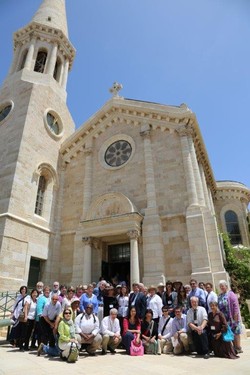“Peace in the Middle East” has to be one of the most aspirational statements ever articulated since 1948 when the state of Israel was established and, soon after, the Arab-Israeli War broke out. For some faithful Presbyterians, however, it’s more than just words; it’s a call to action and witness.
The Mosaic of Peace conference, sponsored by the Presbyterian Church (U.S.A.)’s Peacemaking Program, invites Presbyterians of all ages to witness the diversity, history and culture of present-day Israel and Palestine up close and personal. It allows conference participants to engage with people who seek true peace in this troubled region. The next scheduled event, Mosaic of Peace 2016, will be held April 4-16, 2016.
By most accounts, participants in the 2014 conference had a transformative experience visiting Israel and Palestine. Sue Dravis, a member of the Westminster Presbyterian Church in Dubuque, Iowa, was one of those participants and she agreed to a brief Q & A to detail her experience:
Why should someone attend the Mosaic of Peace 2016 conference?
I don’t believe that I understate the experience by saying that it will be life changing. Having the opportunity to dialogue with Palestinian Christians, Palestinian Muslims and Israeli Jews that live in the land is immeasurable. Too often we listen to the news about what is happening there regarding the Israelis and Palestinians and many too easily dismiss it as “complicated.” As Christians, I believe that we’re each called to dig deeper, to experience for ourselves and to speak the truth to power.
What can one expect from taking this trip to Israel and Palestine?
Biblical history, reflection, interaction, prayer, connection, laughter, joy, empowerment, responsibility, challenge—and walking; any and all of these.

Sue Dravis of Westminster Presbyterian Church in Dubuque, Iowa, at the Sea of Galilee. —Provided by Sue Dravis
How did the 2014 trip personally affect you?
Mosaic of Peace was my second trip to Israel/Palestine. I was a part of the “Group of 100” Presbyterian Peacemaking conference attendees in 2006. As a team leader in 2014, I felt a responsibility to answer questions and talk one-on-one with fellow travelers that were visiting the first time. These interactions were very meaningful; I found that everyone carries along preconceptions that can be difficult to unravel. And seeing the light bulb turn on for those that actually witnessed it, I began to understand the extreme power imbalance between Israelis and the Palestinians.
Have you been able to spread the message about your 2014 experience?
I’ve spoken to ten groups since the 2014 conference: Presbyterian Churches, secular peace groups, and a group of Franciscan Catholic Sisters, to name a few. I always share pictures as well as my personal experiences. I find that many want or need to see the holy sites like the Holy Sepuchre and the Church of the Nativity. But I always feel compelled to show them pictures of Palestinian and Israeli people, as well as signs of the Israeli Occupation—the separation wall, checkpoints, and Israeli-only roads—and explain the challenges faced by Palestinian Christians. This is typically new information for the audience.
Was there any particular experience that still stands out for you?
Visiting Hebron, a short drive from Bethlehem, was a moving experience. Approximately 30,000 Palestinians and fewer than 1,000 Israeli settlers live there and the Israelis are protected by a vast Israeli military presence. Many of the Israeli settlements have been there since 1967. The Mosaic of Peace participants walked through an Israeli checkpoint—staffed by armed soldiers—before entering the Ibrahami (Abraham) Mosque, also called the Cave of the Patriarchs.
A portion of the fortress-like building is for Jewish worship and another part is for Muslims. It has been a site of violence in the past, but we were welcomed into the Muslim section and allowed to walk around freely, pray and absorb the history. It is believed that Abraham and Sarah, Isaac and Rebecca, and Jacob and Leah have been buried there. That night, back at our hotel in Bethlehem, we had a man from Breaking the Silence speak to us. He is a former Israeli soldier who served in Hebron and is now a “refusnik” opposed to the Israeli Occupation. He entered Bethlehem to speak to us without Israeli permission and at some risk to himself. It was a very powerful experience; one that I will never forget.
Carl Horton, Coordinator of the Presbyterian Peacemaking Program and a member of the leadership team managing this year’s conference, said one of the main reasons for organizing Mosaic of Peace 2016 was the impact that the 2014 conference had on its participants:
“It has been remarkable to witness the impact of the 2014 Mosaic of Peace Conference, not only on the participants, but on their congregations and communities. Conference participants returned to their 51 presbyteries transformed by the engagement with Israelis and Palestinians, and from the real life stories and struggles of Christians, Jews and Muslims who all seek peace in the Holy Land. It really was a ‘come and see’ and then ‘go and tell’ opportunity for many of those who attended. I know for a fact the stories from last year’s conference are still being told today, and I am confident that many Presbyterians will want to share their experience from the 2016 conference.”
Registration is now open for Mosaic of Peace 2016. For more information, including a proposed schedule and application, please visit www.presbyterianmission.org/mosaicofpeace. Applications will be accepted until October 15, 2015.

